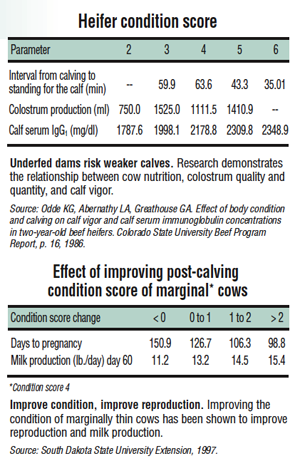
Feeding cows and heifers to maintain the ideal 5 or better condition score going into calving sets the stage for a whole season’s productivity:
- Better newborn survival. Studies have shown that nutritional stress before calving leaves newborns with lower fat reserves to maintain body heat, higher rates of morbidity and mortality. One study showed that heifers fed protein deficient diets dropped calves that generated 11 percent less body heat.
They also took more time to stand after calving than those from dams getting adequate protein.
- Bigger calves without added calving difficulty. Research from the ‘70s disputed the conventional wisdom that thin cows giving birth to smaller calves will suffer less dystocia. Studies since have continued to demonstrate that lower-energy dam diets lead to lowerweight calves–with no decrease in incidence nor severity of dystocia.
- Healthier calves. Research has shown a correlation between cow condition at calving and the concentration of immunoglobulin (IgG) in calves’ blood. Low concentrations of IgGs have been shown to contribute to more scours in young calves.
- Heavier weaned calves. Improved newborn health results in increased calf growth throughout the season. Plus, higher cow body condition improves post-colostrum milk production, further improving calf growth.
- Earlier return to estrus. Colorado State work showed that cows calving in thin condition only achieved a 66 percent cycling rate by 90 days. Moderate conditioned cows, in contrast, improved to 92 percent by 90 days.
- Conception rates increase. Numerous studies have linked nutrition and conception rates. As body condition at calving drops, days to rebreeding increases and conception rate falls.
During the last sixty days of pregnancy, cows generally must get at least two pounds of crude protein daily, plus sufficient energy to maintain fetal growth and development. Heifers need particular attention, both before parturition when they are still growing themselves, and after calving, when new strategic use of rumen-bypass protein has been shown to improve body condition without sacrificing calf growth. Pre- and post-calving nutrition sets the tone for cow herd productivity
Ensuring cows and heifers have sufficient nutrition to maintain and improve condition in the last 50 to 60 days of gestation improves these critical productivity measures:
- Calf growth and survival
- Return to estrus
- Rebreeding performance
Cows need adequate protein before calving, with particular attention to heifers and thinner animals:
- Helps meet animal requirements.
- Improves low-quality forage intake and digestibility.
ECONOMIC IMPACT
Short your cows nutritionally in the last 50 to 60 days before calving, and you risk:
- Fewer calves. Every dead calf leaves an average $300 to $500 in annual cow costs to be covered by the rest of the calf crop.
- Reduced calf immunity to disease. Failure to pass on adequate immunity has been found to lower survival rate all the way through weaning by about one-fifth.
- Lighter weaned calves. Calves that suffer significant disease in the first 45 days of life can be expected to weigh 35 to 40 pounds less than healthy herdmates.
- Longer return to estrus. Every cycle a cow fails to breed subtracts 40 to 50 pounds of marketable calf from your crop.
- Lower pregnancy rates. When undernourished cows cycle, they stand a higher chance of not settling, further pushing the breeding season’s boundaries or–worse yet–going open for the year.


